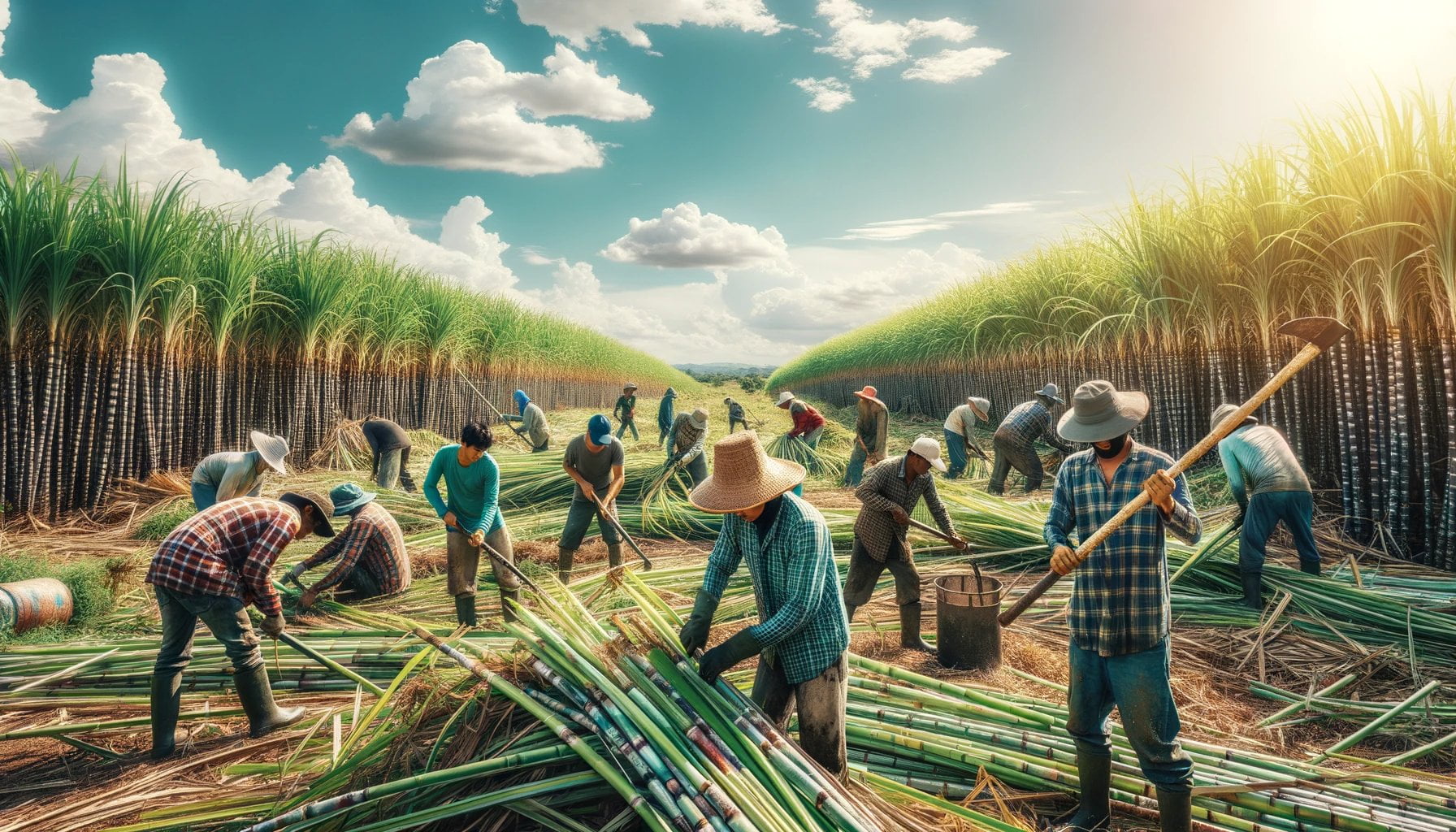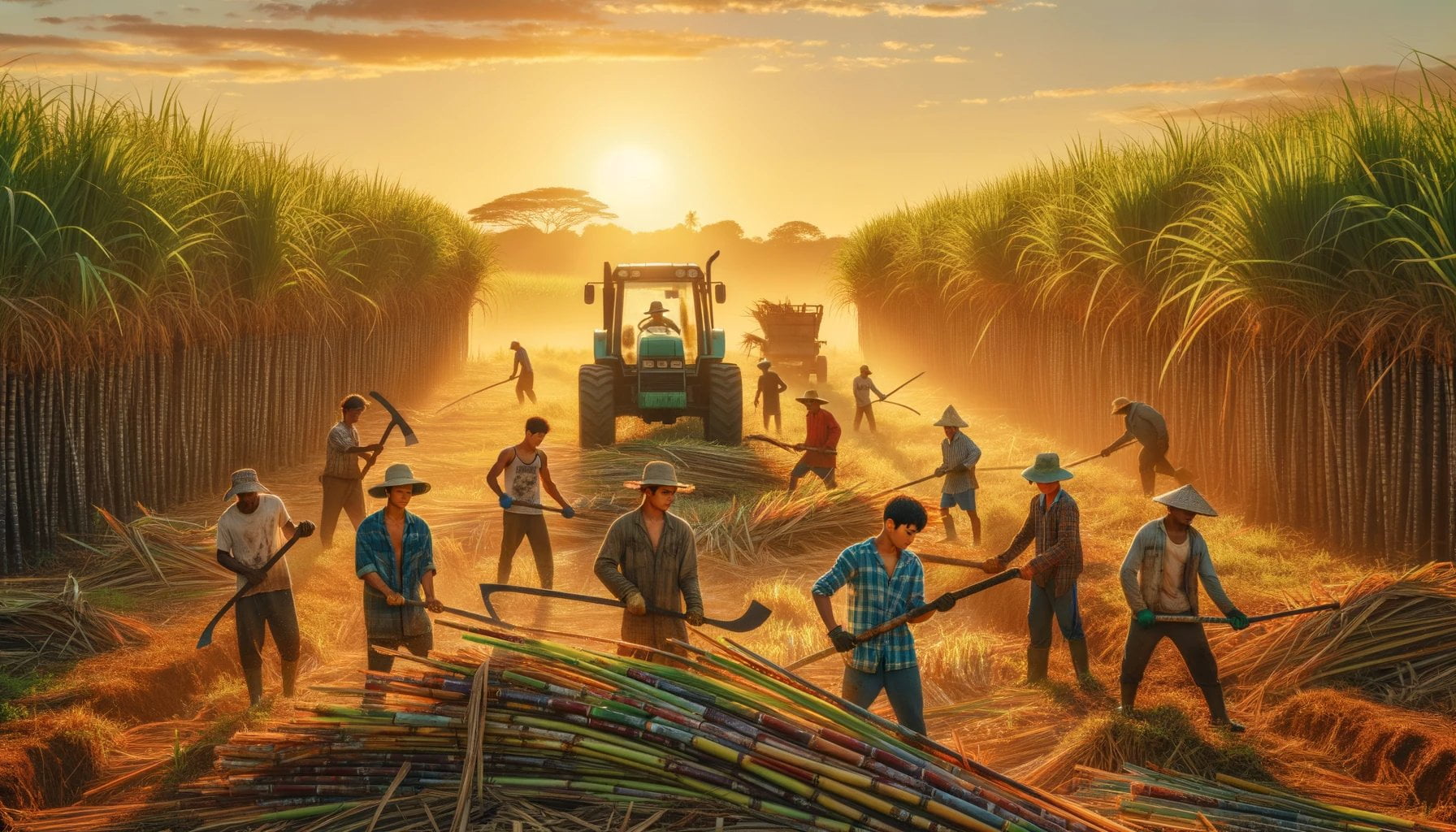Sugar, a sweet staple found in countless treats and beverages, has a fascinating journey from its origins as sugarcane to the refined product we consume daily. In this article, we will delve into the intricate process of growing sugar cane, collecting it from the fields, and the step-by-step manufacturing process that transforms this humble crop into the sweetness we all know and love. Join us as we uncover the secrets of sugar harvesting and explore the remarkable journey it undertakes before reaching our tables.
Key Takeaways:
- Sugar is harvested from sugar cane plants and sugar beets.
- Sugar cane is harvested by cutting the stalks, stripping off leaves and undergrowth, and chopping the stalks into smaller pieces.
- Sugar cane is typically harvested in the cooler months of the year, with mechanical harvesting increasing since the 1940s.
- Sugar beets are harvested, but the specific process is not described in available data.
- At sugar mills, the pieces of cane are shredded and crushed to separate the sweet juice from the fibrous stalk.
- The juice is then filtered and heated to remove water and impurities.
- For sugar beets, the juice is boiled until it crystallizes, and the crystals are separated from the liquid using a centrifuge, resulting in raw sugar.
- Granulated sugar is obtained from both sugar cane and sugar beets due to their high sucrose content.
- Sugar production is possible through the process of photosynthesis, which converts sunlight into energy for plants.
- Several organizations, such as The Sugar Association, the Canadian Sugar Institute, sugar.org.au, Taste of Home, IFT.org, and SugarNutritionResource.org, provide information on various aspects of sugar harvesting and processing.
How is Sugar Harvested?

Sugar is a delightful ingredient that adds sweetness to our lives. But have you ever wondered about the journey of sugar, from its humble beginnings to the refined crystals we sprinkle on our desserts? In this article, we will explore the fascinating process of how sugar is harvested from sugar cane plants and sugar beets.
Sugar Cane Harvesting: Cutting and Crushing
Let’s start with sugar cane, a tall and sturdy plant that grows in tropical and subtropical regions. The harvesting of sugar cane typically takes place during the cooler months of the year. One of the most common methods used is mechanical harvesting, which has gained popularity since the 1940s.
The process begins by cutting the mature sugar cane stalks close to the ground. The leaves and undergrowth are then stripped off, leaving only the stalks. These stalks are then chopped into smaller pieces to make them more manageable for the next step.
The chopped cane is then transported to a sugar mill, where the real magic happens. At the mill, the cane stalks are shredded to extract the sweet juice from the fibrous material. The juice undergoes a series of crushing and squeezing, separating it from the cane fibers.
Sugar Beet Harvesting: Boiling and Centrifuging
Now let’s turn our attention to sugar beets. Unlike sugar cane, sugar beets are root crops that are harvested by uprooting the entire plant from the ground. While the details of the harvesting process may not be as widely discussed, the next steps in sugar production are similar.
Once the sugar beets are harvested, the process of extracting sugar begins. The beets are washed and then boiled, causing the juice to crystallize. These sugar crystals are then separated from the liquid using a centrifuge, resulting in raw sugar.
The Common Path: Refining and Processing
Regardless of whether the sugar comes from sugar cane or sugar beets, the next stage involves refining and processing the raw sugar to obtain the granulated sugar we use in our everyday lives. Let’s dive into this shared pathway.
The filtered juice, whether it’s from sugar cane or sugar beets, undergoes further treatment to remove any remaining impurities and excess water. The juice is subjected to an intense heating process, which helps eliminate water and concentrate the sucrose content.
Through a complex series of clarification steps, the juice is purified, ensuring a high-quality sugar product. This purification process may vary slightly depending on the specific sugar mill or refinery, but the ultimate goal is to produce pure, granulated sugar.
The Significance of Sugar Harvesting
Sugar is not just a simple condiment; it plays a significant role in our daily lives, from sweetening our morning coffee to adding flavor to baked goods. Understanding the process of sugar harvesting allows us to appreciate the effort and precision that goes into producing this essential ingredient.
Moreover, the harvesting of sugar cane and sugar beets has both environmental and economic impacts. With sustainable farming practices and responsible land management, the production of sugar can contribute positively to the health of our planet and support local economies.
Conclusion
The journey of sugar begins in the fields, where sugar cane and sugar beets are carefully harvested. Cutting, crushing, boiling, and centrifuging are just a few of the steps involved in transforming these raw materials into the granulated sugar we enjoy. Through understanding the intricacies of sugar harvesting, we can appreciate the hard work and expertise of those who bring this sweet ingredient to our tables. So, the next time you sprinkle sugar on your favorite treat, remember the fascinating journey it took to reach your plate.
In the world of agriculture, have you ever wondered how is sugar grown? Explore the fascinating journey from field to table by clicking here.
Curious about the process of cotton harvesting? Unearth the secrets of this essential fabric by clicking here.
Looking for a fun fact about sugar? Prepare to be amazed by clicking here.
Discover the surprising truths about corn syrup with a captivating fun fact by clicking here.
Sugar Manufacturing Process Step By Step
The manufacturing process of sugar is a fascinating journey that involves several crucial steps, from the cultivation and harvesting of raw materials to the production of granulated sugar. In this article, we will explore the step-by-step process of sugar manufacturing, diving into the intricacies of each stage.
Cultivation and Harvesting of the Raw Material
Sugar Manufacturing Process Step By Step: The first step in sugar production is the cultivation and harvesting of the raw material. Sugar can be derived from two primary sources: sugarcane and sugar beets. Both of these crops require careful cultivation on large plantations.
Once the sugarcane has matured or the sugar beets have reached their optimal size, they are harvested. Sugarcane is cut close to the ground, and the leaves and undergrowth are removed. Sugar beets, on the other hand, are uprooted entirely from the ground. These harvested raw materials are essential for the subsequent steps in the sugar manufacturing process.
Transportation of Raw Material
Sugar Manufacturing Process Step By Step: After the sugarcane or sugar beets are harvested, they need to be transported to a sugar mill or processing facility. This ensures that fresh raw material is available for further processing. The transportation process must be efficient and timely to maintain the quality of the raw material.
Extraction of the Juice
Sugar Manufacturing Process Step By Step: Once the raw material reaches the sugar mill or processing facility, it undergoes the extraction process. The harvested sugarcane or sugar beets are crushed in a mill to extract the juice. This juice contains the sugars necessary for sugar production.
Clarification and Filtration
Sugar Manufacturing Process Step By Step: The extracted juice often contains impurities that need to be removed. To ensure the production of high-quality sugar, the juice undergoes a process of clarification and filtration. This step eliminates impurities and ensures a clean juice for further processing.
Boiling of the Juice
Sugar Manufacturing Process Step By Step: After clarification and filtration, the juice is ready for further processing. The clarified juice undergoes boiling to create raw sugar. This boiling process involves the removal of excess water, resulting in a concentrated syrup-like substance.
Crystallization and Drying
Sugar Manufacturing Process Step By Step: The concentrated syrup obtained from boiling is then subjected to crystallization and drying processes. The syrup is cooled and spun at high speed in a centrifuge, separating the sugar crystals from the remaining liquid. These crystals are then dried to produce granulated sugar.
Separation of Crystals
Sugar Manufacturing Process Step By Step: The sugar crystals obtained from the centrifuge are separated and further processed to eliminate any remaining impurities. This separation step is crucial in ensuring the production of refined and pure sugar.
Refining of Sugar
Sugar Manufacturing Process Step By Step: The separated sugar crystals undergo refining processes to enhance their quality. This may involve bleaching and additional filtration to achieve the desired level of purity. Refining ensures that the sugar meets the required standards for consumption and application in various industries.
Recovery of Sugar Molasses
Sugar Manufacturing Process Step By Step: Throughout the manufacturing process, a byproduct called sugar molasses is generated. This molasses can be further processed and used in various applications, such as animal feed or the production of ethanol. The recovery of sugar molasses adds value to the sugar manufacturing process, reducing waste and maximizing resources.
Key Takeaways:
- The sugar manufacturing process involves cultivation, harvesting, extraction, clarification, boiling, crystallization, and refining of the raw material.
- Sugarcane and sugar beets are the primary sources of sugar.
- The raw material is transported to processing facilities for further processing.
- Boiling and drying processes are essential for crystallization and the production of granulated sugar.
- Clarification, filtration, and refining steps ensure the removal of impurities and enhance sugar quality.
- Sugar molasses is a valuable byproduct that can be utilized in various applications.
To learn more about the sugar manufacturing process, refer to the following sources:
- Khatabook: “How is Sugar Made? Manufacture, Processing, and Other Features”
- Biology Discussion: “Steps Involved in Manufacturing Cane-Sugar (With Diagram)”
Harvesting
Sugar harvesting is a crucial step in the journey of sugar, whether it comes from sugar cane or sugar beets. This process involves carefully gathering the crops and preparing them for further processing to extract the sweet juice that eventually becomes the sugar we consume daily.
Sugar Cane Harvesting
Sugar cane is harvested by cutting the mature stalks close to the ground and removing the leaves and undergrowth. Once the stalks are cut, they are loaded onto trucks and transported to a sugar mill for processing.
At the sugar mill, the harvested sugar cane goes through a series of steps to extract the sweet juice. First, the stalks are washed to remove any dirt or impurities. Then, they are cut into shreds and pressed to extract the juice. This juice is rich in sucrose, the main component of sugar.
Sugar Beet Harvesting
Sugar beets are a different source of sugar, and their harvesting process also plays a crucial role in sugar production. These beets are uprooted from the ground, and the whole plant is harvested. Once harvested, sugar beets are washed to remove any dirt.
After washing, the beets are sliced into thin strips called cossettes. These cossettes are then processed to extract the juice, which contains the desired sucrose. The juice is then processed further to produce sugar.
Similarities and Importance
While the methods of harvesting sugar cane and sugar beets differ, both plants undergo further processing to extract the sugar. The harvested crops are taken to processing facilities where the juice is separated from the fibers and impurities, and then undergoes clarifying and refining stages to produce pure, granulated sugar. This process ensures that the final product meets the quality standards required for consumption.
The significance of sugar harvesting goes beyond satisfying our sweet cravings. It also has environmental and economic impacts. Sugar cultivation and harvesting can contribute positively to the health of the planet by promoting sustainable farming practices and preserving natural resources. Additionally, the sugar industry supports local economies by providing job opportunities and boosting agriculture-related industries.
Key Takeaways:
– Sugar cane is harvested by cutting mature stalks and removing leaves and undergrowth.
– Sugar beet harvesting involves uprooting the entire plant from the ground.
– Both sugar cane and sugar beets undergo further processing to extract the sweet juice.
– The harvested crops are transported to processing facilities for clarifying and refining stages.
– Sugar harvesting has environmental and economic impacts, supporting sustainable farming and local economies.
Sources:
– Sugar’s Journey from Field to Table: Sugar Cane
– How Sugar Is Processed – IFT.org

FAQ
Q1: How is sugar cane harvested?
A1: Sugar cane is harvested by cutting the stalks, stripping off leaves and undergrowth, and chopping the stalks into smaller pieces. The pieces of cane are then sent to a sugar mill where they are shredded and crushed to separate the sweet juice from the fibrous stalk.
Q2: What is the process of harvesting sugar beets?
A2: While the specific process of harvesting sugar beets is not described in the provided context, once harvested, sugar beets are typically washed, sliced into thin strips called cossettes, and further processed to extract the juice and produce sugar.
Q3: How is sugar extracted from sugarcane and sugar beets?
A3: After the sugarcane or sugar beets are harvested, the juice containing the sugars necessary for sugar production is extracted. The juice then undergoes a process of clarification and filtration to remove impurities, followed by boiling to create raw sugar. The raw sugar is further processed through crystallization and drying processes to produce granulated sugar.
Q4: What happens to the byproduct called sugar molasses?
A4: Throughout the sugar manufacturing process, a byproduct called sugar molasses is generated. This molasses can be further processed and used in various applications, such as animal feed or the production of ethanol.
Q5: What are the steps involved in the sugar manufacturing process?
A5: The sugar manufacturing process includes steps such as cultivation and harvesting of the raw materials (sugarcane or sugar beets), transportation of the harvested materials to a processing facility, extraction of the juice, clarification and filtration of the juice, boiling of the juice to create raw sugar, crystallization and drying to produce granulated sugar, separation and refinement of sugar crystals, and recovery of sugar molasses. Each step is essential in ensuring the quality and purity of the final sugar product.
- Star Ring Trends: Etsy vs Amazon - March 28, 2025
- Boost Pollinator Habitats: Baby Blue Eyes Sustainable Farming Guide - March 28, 2025
- Protect Big Black Bears: Effective Conservation Strategies - March 28, 2025
















